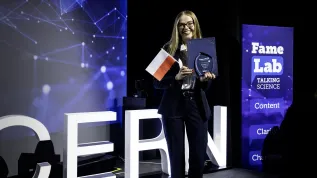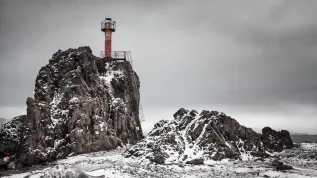
Polish satellite launches, surprising discoveries of animals from hundreds of millions of years ago and archaeological finds that may change scientists' previous findings – these are some of the most important events in Polish science in 2024.
One of the most interesting scientific reports of 2024 fell in January and concerned the discovery of a rare Renaissance Albrecht Hohenzollern coin of in Kamień Pomorski. The silver 3-cent coin 3 was found during cleaning work at the war cemetery in Kamień Pomorski. This is a very rare find in the northern part of Pomerania.
In February, the results of the work of paleontologists captured the imagination of science enthusiasts. First, the media reported that Polish scientists had discovered an unusual fish from 365 million years ago. An over two-meter-long predatory armoured fish with an extremely elongated lower jaw, named Alienacanthusem malkowskii, was found in rock sediments in the Świętokrzyskie Mountains.
Shortly afterwards, the discovery of a lake of bones was announced along with the results of analyses of bones and numerous objects from the Bronze Age. It was tracked down by the Kujawsko-Pomorska Grupa Poszukiwaczy Historii in Papowo Biskupie, in the Chełmno region. According to anthropologists from the University of Lodz, DNA testing of remains from around 1000–450 BC may shake the prevailing theory, according to which the Slavs arrived in present-day Poland only at the beginning of the second half of the first millennium CE.
In March, PAP reported on the development, by Polish engineers from Astronika, of a mechanism for... a lunar jumper leg. The robot, commissioned by the European Space Agency (ESA), is intended to be an alternative to rovers, which do not always handle the difficult terrain of the Moon. The jumper will be able to move freely in the lunar mountains, which often constitute an insurmountable barrier for rovers.
Also in March, it turned out that the common belief that algorithms and artificial intelligence are objective - was wrong. Technology has always reflected the prejudices and stereotypes existing in societies, because the databases on which it is based and learns from are optimised and implemented by people, emphasized scientists from the Kozminski University in Warsaw.
Another interesting report in the field of archaeology came in May. Archaeologists from the Institute of Archaeology of the University of Wrocław, working in Berenike on the Red Sea (Egypt), found papyri with letters from Roman centurions stationed in Egypt. In the place that could have been the remains of a centurion's office, in addition to the documents, the researchers found pottery from Italy, Roman coins and a peculiar coat clasp.
Around the same time, another team, analysing rock art from 2,000 years ago, reported new interpretations of petroglyphs from Toro Muerto (Peru). Geometric patterns, lines, zigzags that accompany images of dancers (danzantes), carved in local rock blocks are not snakes or lightning bolts, but a record of songs, the authors of the analyses suggested. Toro Muerto is one of the richest places in rock art in South America. Rock carvings, or petroglyphs, created at different times, have been preserved on thousands of volcanic boulders.
Also in May, scientists announced that - due to its physicochemical composition - Polish smog was particularly dangerous for the circulatory system: it increased the risk of heart attack and stroke. Cardiologist Łukasz Kuźma, PhD, told PAP that this was our 'new, inglorious regional product'. This was confirmed by the research of the team from the Invasive Cardiology Clinic of the Medical University of Białystok under his supervision.
The naming of two asteroids in honour of Polish scientists attracted great interest. The celestial bodies discovered by Lithuanian astronomers were given names honouring Władysław Dziewulski and Marcin Poczobutt-Odlanicki.
Information about the research of scientists from the University of Warsaw on an extinct reptile with extremely elongated cervical vertebrae appeared in the media in June. The extremely long neck of the Tanystropheus, which was half the length of its body, consisted of only 13 vertebrae, but they were extremely elongated. Tanystropheus lived in the Triassic period, about 240 million years ago, also in in the lands of modern-day Poland (fossils were found, among other placess, in Miedary, Silesia).
In July, during tests, the Polish suborbital rocket ILR-33 BURSZTYN 2K reached an altitude of 101 km. 'This is a breakthrough event in the history of Polish science and the achievements of Polish engineers in the field of space technologies', we read in the Polish Space Agency (POLSA) and the Łukasiewicz Institute of Aviation press release. BURSZTYN is the first rocket in the world to use hydrogen peroxide at a concentration of 98 percent as an oxidizer.
Also in July, Polish divers reported the discovery of a wreck full of bottles at the bottom of the Baltic Sea. The wreck of the 19th-century sailing ship was filled with about a hundred bottles of champagne and mineral water. The expedition leader estimated that the vessel could have sunk near Sweden between 1850 and 1876.
In August, SpaceX's Falcon-9 rocket launched the Polish satellite EagleEye into orbit. The largest and most advanced Polish orbiter began transmitting telemetry data almost immediately, but went silent a few days later. According to Jacek Kosiec, VP of Creotech Instruments, where the satellite was built, EagleEye worked great for a week, and then the operators lost two-way communication with it.
One of the more interesting reports after the summer holidays concerned the discovery of about 300 artefacts at the 'Łysa Góra' site in Mazovia, including iron axes, scissors, and a unique helmet from the 4th century BCE. Bartłomiej Kaczyński, PhD, who led the research, assessed that the helmet was an example of advanced Celtic metallurgy. The discovery changes the previous view of the scale of contacts with the Celtic world in the older pre-Roman period.
At a similar time, researchers working in Tanzania's Serengeti National Park reported the discovery of over 30 valuable archaeological sites and the identification of previously unknown rock paintings, fragments of pottery and stone tools. The research in Serengeti is being conducted by a team led Marta Osypińska, PhD, from the Institute of Archaeology of the University of Wrocław.
In Kazimierza Wielka in the Świętokrzyskie province, researchers discovered the remains of 160 archaeological objects related to Neolithic settlement and the early Bronze Age. The Kraków archaeologists mentioned the cemetery, dated to the younger pre-Roman period and the early Roman period (1st century BCE - 2nd century CE), as particularly interesting.
October was marked by an exceptional collection of oriental fashion presented by the Louvre in Paris. The costumes of kings, royal mothers and a bishop from medieval Nubia were reconstructed by Polish researchers from the University of Warsaw and designers from the SWPS University, based on paintings that once decorated the walls of the cathedral in Faras.
A team of researchers from Kraków in cooperation with foreign partners examined the adaptation mechanisms of bacteria collected from the International Space Station (ISS). The findings indicate that microorganisms isolated from the interior of the ISS have adapted to life in space. The studies of microorganisms that travelled with astronauts to the ISS and settled on the space station were conducted by a team of researchers from Kraków research units: the Małopolska Centre of Biotechnology of the Jagiellonian University and the Sano Centre for Computational Personalized Medicine in close collaboration with partners from the NASA's Jet Propulsion Laboratory and Acibadem University in Istanbul.
One of the most interesting reports in October concerned the scale and mechanisms of people leaving science. This phenomenon was studied in various countries by Professor Marek Kwiek and Łukasz Szymula, PhD, from Adam Mickiewicz University in Poznań. They found that only half of people were still active scientists 10 years after their first scientific publication. And after 20 years, only one third of people remained in science. The patterns of leaving science are similar in other countries.
In November, scientists published a method of combating the dangerous Staphylococcus aureus. Viruses that attack bacteria and small proteins called bacteriocins help to deal with dangerous strains of this bacteria that are resistant to antibiotics. This is indicated by research conducted by scientists from the Institute of Biochemistry and Biophysics of the Polish Academy of Sciences.
In December, four scientists: Sebastian Glatt, PhD, Professor Janusz Lewiński, Professor Krzysztof Sacha and Professor Marcin Wodziński received the Foundation for Polish Science Prizes. The awards were given for the 33rd time.
The end of the year in science was dominated by the topic of space missions. In December, the Proba-3 double satellite was launched into space. Two satellites were carried into orbit by a rocket from the Indian Satish Dhawan Space Center. The formation created by the coronagraph, i.e. a telescope for observing the solar corona, and the occulter - an element with a disk obscuring the disk of the Sun - will create an artificial solar eclipse every 20 hours for two years. All this to enable scientists, including researchers from the Space Research Center of the Polish Academy of Sciences, to observe the solar corona.
The official name of the first Polish mission to the International Space Station was also announced. As part of Ignis (Latin for 'fire'), astronaut Sławosz Uznański will conduct 13 experiments in orbit, in the fields including technology, biology, medicine and psychology. The experiments were prepared by Polish scientists and engineers. Uznański will fly into orbit in the spring of 2025. (PAP)
Anna Bugajska
abu/ zan/ mow/













